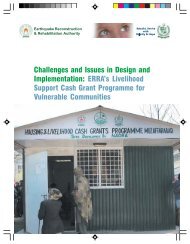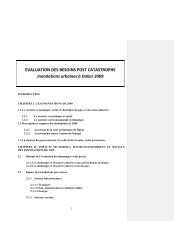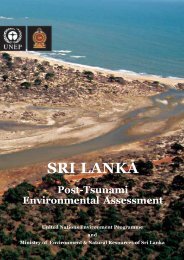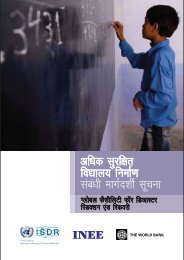Secretariat - International Recovery Platform
Secretariat - International Recovery Platform
Secretariat - International Recovery Platform
You also want an ePaper? Increase the reach of your titles
YUMPU automatically turns print PDFs into web optimized ePapers that Google loves.
阪 神 ・ 淡 路 大 震 災 からの 復 興<strong>Recovery</strong> from the GreatHanshin-Awaji Earthquake--- Lessons and Good Practices ---<strong>International</strong> <strong>Recovery</strong> <strong>Platform</strong><strong>Secretariat</strong>Masahiko MURATAIRP 事 務 局 村 田 昌 彦
Damage by the Great Hanshin-Awaji Earthquake阪 神 ・ 淡 路 大 震 災 の 被 害 の 概 要Scale: Magnitude 7.3Seismic intensity:7 on Japanese scaleEpicenter:South Hyogo (North Awaji Isl.)Dead:6,433 peopleFinancial damage:$ 87 billion (2.5% of GDP)Evacuees: 316,678 people at peakEvacuation centers: 1,153 locationsCompletely/ Half destroyed:249,180 bld’gsSeismicintensity7
Railways were mangled鉄 道 の 被 害
Collapsed building住 宅 の 被 害
82.5 Billion US$ Worth Damage被 害 総 額 9 兆 9 千 億 円48.32.94.62.48.30,052.81.01.40.030.43.51.05.20.6282.5 (in US$ billions)
Progress of ReconstructionCategoryElectricityGasWaterImmediately after theearthquakeApproximately 2.6 million houseshad no electricity (including thenorthern area of Osaka prefecture)Approximately 845,000 houseswere without gasApproximately 1.27 million houseswithout water supplyState of recovery23rd January 1995Totally restored exceptfor completely destroyedhouses11th April 1995Completely restoredexcept for completelydestroyed houses28th February 1995Partially restored17th April 1996 totallyrestored to all housingSewage 260km of pipes were damaged 20th April 1995 PartiallyrestoredTelephoneExchanges: Approximately 285,000 lineswere out of orderSubscriber Lines: Approximately 193,000lines were out of order(Essential lines)被 災 地 の 復 旧 状 況 (ライフライン)18th January 1995completely restored31st January 1995completely restored
Progress of Reconstruction (Urban Infra)被 災 地 の 復 旧 状 況 ( 都 市 インフラ)Roads道 路Railway鉄 道Ports港Main recovery projectsChugoku ExpresswayMeishin ExpresswayHanshin Wangan ExpresswayRoute 2 Hamate BypassHarbor HighwayHanshin Expressway Kobe RouteJR West (Kobe Line)JR West (Sanyo Shinkansen)Hankyu Railways (Kobe Line)Hanshin Railways (Main line)Kobe Shinkotsu (Rokko Liner)Kobe PortAmagasaki-Nishinomiya-Ashiya PortDate ofcompletion21.Jul. 199529.Jul. 19951.Sep. 19952.May 199624.Aug. 199630.Sep.19961.Apr. 19958.Apr. 199512.Jun. 199526.Jun. 199523.Aug. 199531.Mar. 199731.Mar.1997
<strong>Recovery</strong> Status ---Smooth <strong>Recovery</strong>---被 災 地 の 復 興 状 況 ・・・スムーズな 復 興PopulationJanuary 19955,526,689(3,589,126)Gross PrefecturalProduction (GPP)FY 1994About $163.3 bil.( About $103.3 bil.)Ratio of job offersto seekersJanuary 199545/100(35/100)March 20055,593,901(3,626,306)FY 2003About $165.8 bil.(About $102.5 bil.*)January 200579/100(76/100)※Numbers above: Whole Prefecture; Numbers in ( ): Disaster-affected regions; GPP is for fiscal 2002
The Great Hanshin-Awaji EarthquakeReconstruction Plan (Hyogo Phoenix Plan)阪 神 淡 路 大 震 災 復 興 計 画 (ひょうごフェニックス 計 画 )•Started 4 days after the disaster4 日 後 から 策 定 に 着 手 、7 月 に 完 成•Adopted in July 1995•Targeted completion: 2005•Targeted areas: 10 cities and 10towns被 災 10 市 10 町 10 年 計 画
Hyogo Phoenix Planひょうごフェニックス 計 画Creative Reconstruction ---Better than pre-quake--●Harmonious Coexistence between People & Nature/SocietyFive pillars 創 造 的 復 興 ‣Creation of a WELFARE society tailored for the 21 stcentury‣Creation of a CULTURALLY rich society open to theworld‣Creation of a society where existing INDUSTRIES growand new INDUSTRIES flourish‣Creation of a DISASTER-RESISTANT metropolis wherepeople can live with confidence‣ URBAN DEVELOPMENT with multi-centered networktypemetropolitan area
Priority 3-year Reconstruction Plans緊 急 3ヵ 年 計 画1) Housing 2)Industry 3)Infra Structure住 宅 産 業 インフラPlannedTarget目 標Achieved達 成Housing(Unit)125,000(Order base)173,300*(139%)Industry100.0%(Net Reg.Product base)Infrastructure¥5.7 tril(Budget base)101.7% ¥5.87 tril(103%)• Overall target level was achieved by March 1998* As of end of March 2000 (169,000 as of 1998)
Emergency Temporary Houses仮 設 住 宅 :48,300 戸 建 設•First order 2,961 units on 19 Jan. Total 48,300•Based on the survey on 22 Jan. at shelters30,000 completed before end of March 1995•46,000 families at max. (Nov.1995) 5 年 で 解 消Moved to permanent houses by Jan.’05(5years)OccupiedRemoved1y 2y3y 4y5y
Problems in the Emergency Temporary Housing仮 設 住 宅 での 問 題 点Aimed quick and mass providingLottery was introduced for equality• Broke current community• Far, inconvenient, narrow, hot, cold……..• over 200 die of loneliness 孤 独 死 >200 人コミュニティの 崩 壊• Life support advisors’ visit LSAの 訪 問• Established community centers (50 units up)56 community centers opened コミュニティセンター• Mutual voluntary activities were effective• Mental care was taken
Significance of Quake-Resistance Housing住 宅 耐 震 化 の 重 要 性88% of the victims were by building collapse死 亡 原 因 の88%は 建 物 の 倒 壊Main Cause of DeathNo. of death(3) 2%(1) Collapse of Buildings建 物 の 倒 壊4,831 88%(2) 10%(2) Fire 火 事 550 10%(3) Others(Slide, Transportation)121 2%(1)88%Total 5,502Hyogo Pref. Police HQ
100%80%60%40%20%0%Building Damage by construction date建 築 年 次 による 被 害 の 違 い25%40%57%31%35%16%(17) 12% (5) 8% (3)-1971 1972-81 1982-Collapse/Ser. Dmg 全 壊Moderate/Minor 半 壊Slight/NoDamage 一 部 損 壊In Japan, 21mil. houses are built before 1981 (out of 44mil)14mil. Houses are not seismic resistant: needs reinforcement全 国 4,400 万 棟 。1981 以 前 は2,100 万 棟 。うち1,400 万 棟 が 要 補 強75%(Collapse 倒 壊 )
Reinforcement of the structures重 要 構 造 物 の 耐 震 補 強
To Support <strong>Recovery</strong> of the Livelihoods被 災 者 の 生 活 ・ 住 宅 再 建 支 援Act concerning Support for Reconstructing theLivelihoods of Disaster Victims < 居 住 安 定 支 援 制 度 >‣ to support the reconstruction of the livelihoods‣ fund co-provided by the national and prefecturalgovernments‣ Up to ¥3 mil. ($25,000) will be providedHyogo Mutual Aid System for Housing Reconstruction< 住 宅 再 建 共 済 制 度 >‣ A complete new system adopting an idea of “mutual help,” aframework for mutual support among homeowners, to overcomethe limited resources in both “self help” such as savings andearthquake insurance, and the “public help” from the government‣ Regardless of the size, structure and superannuation of thehousing, by paying fixed allotments, applicants can receive thefixed amount of provision (up to ¥6 mil. / $50,000)
Community Involvement住 民 参 加 のまちづくりCommunity development with citizensまちづくり 協 議 会●Establishment of the Society-Creation Conferences→Reflect the opinions of citizens to community development● Urban planning in double layers→The administration decides the overall urban planning, and theelaborate community development will be decided by citizens themselves
Significance of the Local Communities地 域 コミュニティの 重 要 性● During the immediate aftermath of a large-scale disaster or an accident,volunteer fire extinguishing activities & rescue/aid activities by localcitizens are very effective.Among some 35,000 people who suffered difficulties in evacuating themselves:19% were savedby rescue workers4% by others77% were saved bytheir neighbors77%は 近 隣 住 民が 救 助 。警 察 消 防 は19%
Improving & Reinforcing Volunteer DisasterResponse Groups 自 主 防 災 組 織 の 育 成 支 援Support the improvement and reinforcement of the system andfunction of volunteer disaster response groups●Implement training to nurture leaders, and offer goods and equipment●Percentage of households participating in volunteer disaster response groups27.4% (1995) →94.7% (2005)Participating rate in VDR groups (%)1995 1996 1997 1998 1999 2000 2001Time
Disaster Reduction and Human Renovation Institution人 と 防 災 未 来 センターTransfer Live lessons to the World and the Next Generation災 害 の 経 験 と 教 訓 を 語 り 継 ぐ‣Possible to relive the earthquake through a film that reenacts the event‣Collected and exhibiting materials related to the disaster (160,000)‣Training personnel in charge of disaster management‣Expert research, study and advise on disaster-hit areasCollect, store, andexhibit materialsResearch byexpertsEffective &practicaltrainingDispatch of expertsin times of disaster
Asian Disaster Reduction Centerアジア 防 災 センター25 Member Countries, 5 Advisor Countries, 1 Observerアジア25ヶ 国 がメンバーPakistan※Implement Various Projects in cooperation with UN/ISDR, UN/OCHA, UNESCO,UNU, WMO, UN/ESCAP, etc.
Hyogo Institute for Traumatic StressこころのケアセンターProviding mental support in times of disaster & accidentsこころのケアに 関 する 実 践 的 研 究 ・ 研 修● Specialized treatment for trauma/PTSD● Research on treatments for trauma/PTSD● Training for medical experts and interested citizens● Health counseling & mental care in disaster-affected areasCounseling &CareStudy &ResearchCollaboration& ExchangeCollection &Dissemination ofInformationHuman ResourceDevelopment
Post-disaster <strong>Recovery</strong>復 興 期 の 課 題Post-disaster recoveryoften leads to rebuilding risk急 いだ 復 興 はリスクの 再 構 成 につながるDisaster risk reduction should be taken up as anaim in recovery activities復 興 にリスク 軽 減 の 視 点 をNeed for recovery coordination, experience/knowledge sharing, capacity building andjoint assessment methodologies調 整 機 能 、 知 識 の 集 積 ・ 共 有 、 人 材 育 成
Priority Activities of IRPIRPの 優 先 活 動IRP functions in line with HF, 兵 庫 行 動 枠 組 みの 実 践“incorporate disaster risk reduction into postdisasterrecovery through building capacity andsharing expertise, knowledge and lessonslearned” 優 良 事 例 の 共 有 ・ 人 材 育 成 によるリスク 軽 減 Advocacy andKnowledge ManagementFacilitate the dissem. of lessons CapacityBuild. And TrainingStrengthen national capacitiesIRP Provide a coordination frameworkand network Enhanced <strong>Recovery</strong> Operationsジュネーブ Provide advice/ support onformulation of reconstruction plan
WGER Pakistan Earthquakeパキスタン 地 震 の 早 期 復 興 ニーズアセスメントミッション
Thank you for your attention<strong>International</strong> <strong>Recovery</strong> <strong>Platform</strong><strong>Secretariat</strong>Masahiko MURATAIRP 事 務 局 村 田 昌 彦


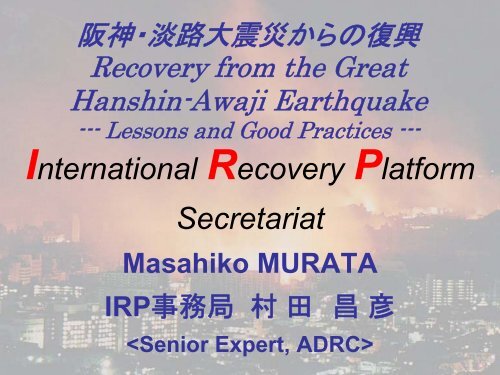


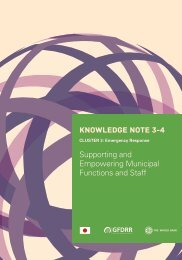
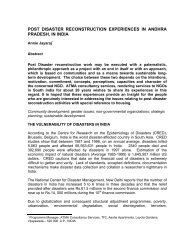
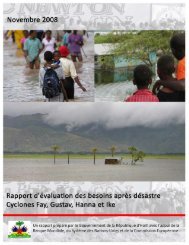
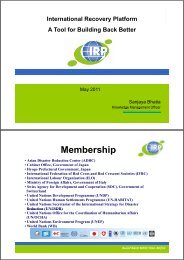
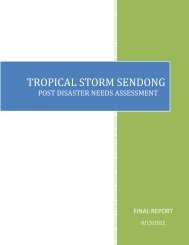
![View full document [PDF 7.65 MB] - unisdr](https://img.yumpu.com/48902806/1/178x260/view-full-document-pdf-765-mb-unisdr.jpg?quality=85)
